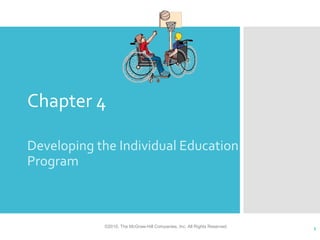More Related Content
Similar to Auxter 11 ppt_ch04 (20)
Auxter 11 ppt_ch04
- 2. Present level of Educational Achievement
Goals
Specific Educational Services
Related Services
Extent to which the students will not
participate in
Components regular education
of the IEP Modifications/accommodations for
statewide testing
Transition services
Behavior management
Dates of services
Evaluation procedures
©2010, The McGraw-Hill Companies, Inc. All Rights Reserved.
2
- 3. Include information from parents,
general physical educator, and adapted
physical educator
Results of formal assessment
Present Level
of Results of informal assessment
Educational Strengths and weaknesses
Achievement How the student’s disability impacts
his/her performance in the general
curriculum
©2010, The McGraw-Hill Companies, Inc. All Rights Reserved.
3
- 4. Must be measurable
Address needs resulting from disability
Aligned with the general curriculum
Goals
Include action, condition,
and criteria
©2010, The McGraw-Hill Companies, Inc. All Rights Reserved.
4
- 5. Action
What the student is doing….hop,
jump, throw, run, slide
Condition
Action, How the student performs the skill…
Condition, with eyes closed, with arms out,
backwards
Criteria
Criteria
At what level….3/5 trials, for 10
seconds, 10 repetitions
©2010, The McGraw-Hill Companies, Inc. All Rights Reserved.
5
- 7. Beginning and ending of services (dates)
Duration of services
Number of minutes
Implications for APE….adapted
physical education should be
provided MINIMALLY the same
Specific amount as general physical
Educational education is provided for students
Services without disabilities, unless the IEP
team determines otherwise
Location of services
Important to identify for APE, as
there are often space/location
difficulties for APE. Options should
be explored prior to the IEP meeting
©2010, The McGraw-Hill Companies, Inc. All Rights Reserved.
7
- 8. Why is adapted physical education not a
related service?
Examples of related services include:
Occupational therapy
Physical therapy
Speech and Language therapy
Related Counseling
Services Psychological services
Recreation therapy
Assistive technology
Social worker
©2010, The McGraw-Hill Companies, Inc. All Rights Reserved.
8
- 9. Special educators
Hospital/homebound instructors
Instructors in institutions
Direct Service Adapted physical educators
Providers
General physical educators
Vision specialists
Orientation and mobility specialists
©2010, The McGraw-Hill Companies, Inc. All Rights Reserved.
9
- 10. Prior to removal, documentation of
services and accommodations
attempted should be provided
Participation
in Regular Services and accommodations include:
Modified equipment, rules,
Education
environment, and instruction
Human assistance
Peer tutors, paraprofessionals,
parent volunteers
©2010, The McGraw-Hill Companies, Inc. All Rights Reserved.
10
- 11. Purpose is to prepare students for active
living after graduation
Must be included in the IEP or
Individualized Transition Program (ITP)
Transition by age 16.
Services Some states have earlier age
requirements
Input from the student and parents
should be included
©2010, The McGraw-Hill Companies, Inc. All Rights Reserved.
11
- 12. Positive reinforcement is key
Behavior Management Plans should be
provided to all of the student’s teachers
and should be followed exactly as
written
Behavior There are legal guidelines for when a
Management child violates a code of conduct
Describe the steps educators are
required to follow if the above
occurs
©2010, The McGraw-Hill Companies, Inc. All Rights Reserved.
12
- 13. Dates are usually set annually
IEPs are dated from the date goals were
Dates of accepted by the IEP team, to one year
Services later….eg. From: 09/15/07 To: 09/14/08
©2010, The McGraw-Hill Companies, Inc. All Rights Reserved.
13
- 14. IDEIA no longer requires submission of an
evaluation report
What are the implications of this
guideline?
Assessments utilized and the results of
Evaluation those assessments must be provided
Procedures How progress on IEP goals will be measured
Checklists, rubrics, video clips, digital
pictures
When progress on IEP goals will be reported
Every six weeks, quarterly, every two
weeks, weekly electronic journal
©2010, The McGraw-Hill Companies, Inc. All Rights Reserved.
14
- 15. Schools should provide their best efforts
to make the IEP process accessible and
inviting to parents. Some efforts
include:
Providing information in the native
Parental language
Considerations Avoiding jargon
Soliciting and including opinions
Schedule meetings at a convenient
time
Report regularly on student progress
©2010, The McGraw-Hill Companies, Inc. All Rights Reserved.
15
- 16. Parents
Regular education teacher
Special education teacher
School administration
IEP Team Evaluator
Members Related service personnel
Student
School nurse
Interpreter
Community agency representatives
©2010, The McGraw-Hill Companies, Inc. All Rights Reserved.
16
- 17. Include the student
Highlight positives
Collaborate
Successful Provide guidelines
IEP
Take notes
Meetings
Listen
Offer drinks and/or snacks
©2010, The McGraw-Hill Companies, Inc. All Rights Reserved.
17
- 19. Active living after high school
Self-determination and student personal
interests should be the center of
transition planning
Training in the community environment
is most effective
Transition
Community recreation activities should
be identified and task analyzed to
determine student needs for
participation and access
©2010, The McGraw-Hill Companies, Inc. All Rights Reserved.
19
- 20. Websites
PE Central
Assessment Tips
Assessment Guidelines
Test of Gross Motor Development
Assessments Test of Gross Motor Development
Rubrics
Examples of fun activities to help
improve Gross Motor Skills
Gross Motor Skills – PE class of
elementary school age students
©2010, The McGraw-Hill Companies, Inc. All Rights Reserved.
20
Editor's Notes
- CPS Question #3 (MC)
- CPS Question #4 (MC)
- CPS Question #5, #6, #7 (MC)
- Insert table 4-7
- CPS Question #9 (MC)
- Insert table 4-10
